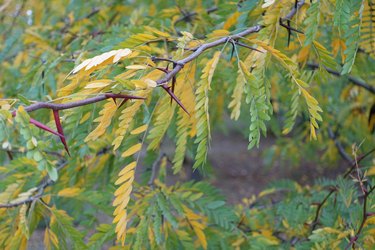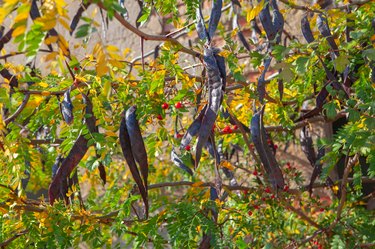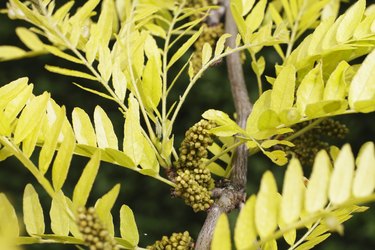
Pruning a honey locust tree (Gleditsia triacanthos) can equal an adventure in medieval warfare or be as simple as a cut and snip, depending on whether your tree is thornless or has 8-inch-long spikes emanating from the branches. This anomaly in tree structure is the only difference in the makeup of the two trees and doesn't require a separate scientific name; therefore, the thornless version is a "form" of honey locust. Arm yourself with protection when pruning a honey locust with thorns or consider the yearly pruning of a newly planted thornless honey locust your obligation to guiding this otherwise lovely tree to maturity.
Tip
Never “top” a tree by cutting off its canopy to reduce the size. You are removing its lifeblood and slowly killing the tree.
Video of the Day
Caring for a Honey Locust Tree
One of the easiest trees to grow, the honey locust tree flourishes in U.S. Department of Agriculture hardiness zones 4-9. The tree adapts to a wide range of soil conditions and tolerates most weather as long as it has at least six hours of sun per day. Train a young honey locust tree by pruning and shaping it so it grows into a well-formed mature tree that requires little attention.
Video of the Day
Because of their minimal requirements when mature, the honey locust is a popular addition to roadside landscaping, parking lots and urban exteriors. It needs a wide median when considering adding it to parkways, but as a residential addition it just needs space to spread out as it grows 30 to 70 feet tall and 30 to 70 feet wide. Because it tolerates salt, it is the ideal tree for planting where winter snows and ice require salt treatments.
When to Prune a Honey Locust Tree
As with most trees, pruning is ideal in the fall when the leaves have fallen or in the spring before any sap appears. By pruning the tree when it's young, you provide a growth pattern which gives the tree shape. Look for branches that are crossing and eliminate one, giving the other room to grow. The tree should not be crowded when leaves develop. An open canopy allows for sun to pass through to the bottom branches and also feeds the grass growing underneath.

When pruning, start from the bottom and cut at a 45-degree angle. Remove the suckers as soon as they appear. It's not necessary to use a salve over the cut. If branches have spread horizontally, trim them to corral the growth. You want to create a shape that conforms to the space in which the tree grows. Remove dead branches any time of the year.
Living With Honey Locust Tree’s Thorns

Long, sharp thorns grow on some forms of honey locust trees. If you must contend with the thorns, pruning is highly advised, starting when the tree is young. The thorns are denser at the bottom of the tree, and they grow in clusters. Use a sharp knife, pruning shears or loppers to remove the thorns, then burn them.
The thorns are not poisonous, but they do collect pollutants on the outside. If a skin puncture occurs, wash immediately to prevent infection. While the thorns are the most dangerous part of the tree, they also have served many useful purposes, such as use as fish hooks, spearheads, nails, needles and small game traps. At one time in the south, the honey locusts were referred to as "Confederate pin trees" as Confederate soldiers used the thorns to pin their uniforms together. Just tread carefully when walking through a wooded area populated by honey locust trees.